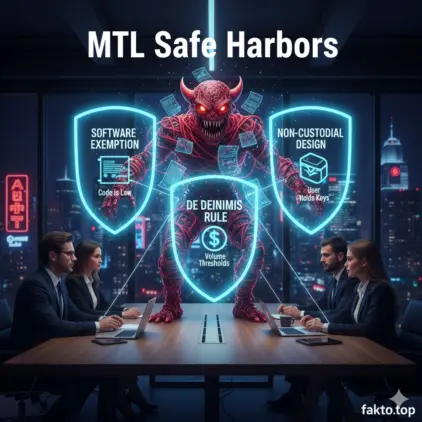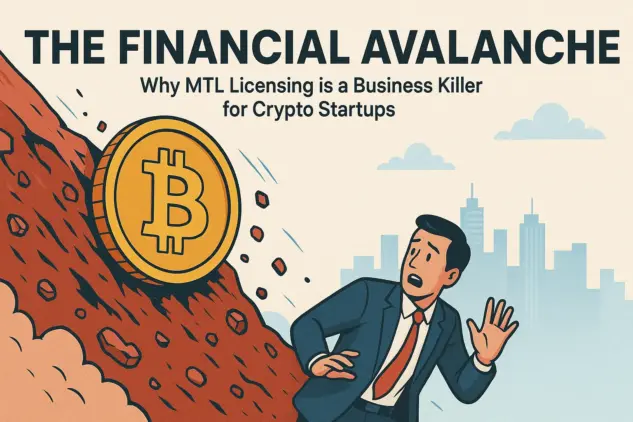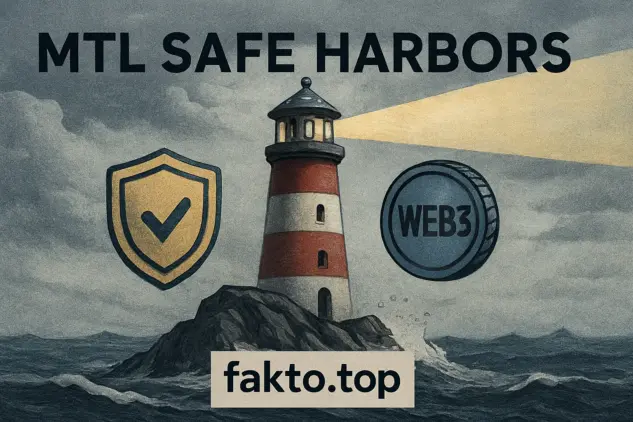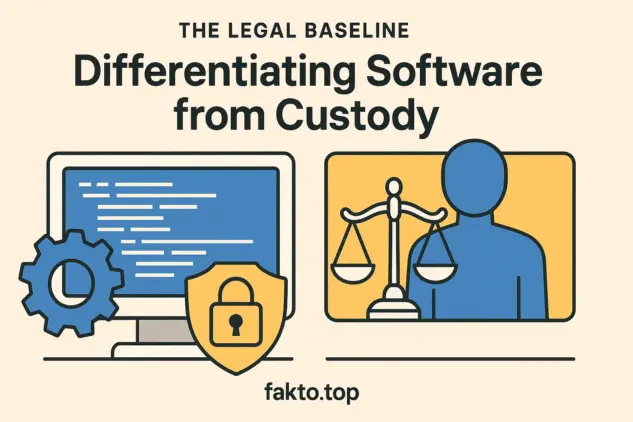MTL Safe Harbors: How Web3 Legally Avoids US Crypto Licensing
The Invisible Monster of US Crypto: How Web3 Projects Legally Avoid Money Transmitter Licensing (MTL Safe Harbors)
The Financial Avalanche: Why MTL Licensing is a Business Killer for Crypto Startups
There’s a monster in the shadows of U.S. crypto law — and it’s not the SEC. It’s called Money Transmitter Licensing (MTL). For thousands of Web3 founders, it’s the silent killer that turns promising projects into expensive legal nightmares.
Imagine building a decentralized app, finally gaining traction, and then realizing that you might need forty-five separate state licenses just to let users send tokens to each other. Each state has its own laws, rules, forms, and fees. There’s no single federal license that covers you everywhere — just a tangled web of bureaucracy built long before crypto ever existed.

The problem is historical. MTL laws were designed for 20th-century remittance companies like Western Union — businesses that physically handled other people’s money. But the laws never evolved to distinguish between a centralized custodian and a software developer building open-source smart contracts. As a result, nearly every crypto project that touches “value transfer” could theoretically fall under these outdated statutes.
That’s why founders fear those five letters — MTL. Getting compliant across the entire U.S. map is a logistical and financial avalanche. You’re dealing with more than 45 separate state banking departments, each demanding proof of net worth, compliance officers, surety bonds, audits, and annual renewals. Multiply that by 45, and even a well-funded startup starts to sweat.
The irony? Most Web3 projects never actually hold anyone’s money. They just write code. But to the state regulators, “value transmission” doesn’t care whether the sender is a human or a smart contract — it only cares that money moves.
That’s the trap: the crypto money transmitter license in the US isn’t just a formality. It’s a multi-million dollar sinkhole that most startups don’t survive. Let’s see why.
Analyzing the Financial Burden (SC Cost Analysis)
Let’s be blunt — the cost of MTL compliance is crippling. Every state has its own filing fees, bonding requirements, and annual reporting costs. Even if you wanted to comply, you’d need a small legal army and a bank-level budget. Below is a breakdown of the three biggest financial barriers that make MTL the death zone for small Web3 teams.
| Expense Type | Purpose | Volume (Per 1 State) | Problem for a Startup |
|---|---|---|---|
| Licensing Fee | Right to submit and process application | $5,000 – $20,000 | Must be multiplied by 45+ states; prohibitive entry barrier. |
| Surety Bond / Net Worth Requirement | Guarantee of financial responsibility | $25,000 – $500,000 | Aggregated obligations reach millions; unsustainable for early startups. |
| Audit & Compliance Costs | Annual regulatory, legal, and operational checks | High (varies per state) | Requires full-time compliance staff; incompatible with decentralized design. |
That table doesn’t even include the hidden costs — the months spent on paperwork, the opportunity cost of delayed launch, and the chilling effect it has on innovation. Many founders look at the numbers and decide to move their projects offshore or abandon them entirely.

The truth is simple: no bootstrapped Web3 startup can afford to chase 45 different state licenses. It’s a legal maze with no finish line. And yet, under U.S. law, operating without an MTL when required can lead to heavy fines or even criminal penalties. So what’s the way out?
The answer lies in two words that every crypto builder should tattoo on their brain: federal baseline. Because before you deal with the states, you need to understand what the FinCEN — the federal regulator — actually says. That’s where the real clarity begins.
The Legal Baseline: Differentiating Software from Custody
FinCEN MSB Registration: The Federal Barrier
Before you panic about 45 state licenses, take a breath. The first question is federal — and it comes from FinCEN, the Financial Crimes Enforcement Network. FinCEN sets the nationwide baseline for who is (and isn’t) a Money Services Business (MSB). Understanding this line can save your startup before it even gets tangled in state laws.
FinCEN’s logic is actually simple — if you hold, move, or control someone else’s money, you’re a money transmitter. If you just write code that helps people move their own money, you’re not. That’s the whole game.
Back in 2019, FinCEN quietly released a piece of guidance that every crypto founder should frame on their wall. It clarified that developers of non-custodial software — wallets, decentralized exchanges, smart contracts — are not considered money transmitters, as long as they don’t actually take possession of the funds. In other words, if you never touch the money, FinCEN won’t treat you like a bank.
That single line — “no custody, no license” — is the oxygen mask for DeFi. It’s why projects like MetaMask, Uniswap, and countless wallet providers exist legally in the U.S. They don’t need federal MSB registration, because the users control their own private keys.
However, FinCEN’s blessing comes with strings attached. Even if you’re not an MSB, you’re still part of the larger compliance universe — especially when it comes to KYC/AML compliance and the FATF Travel Rule. You can’t just ignore the rules completely. If your protocol facilitates transactions between users, regulators still expect basic anti-fraud and sanctions awareness.
So at the federal level, the rule is clean: build non-custodial, stay code-only, don’t handle user funds. But the moment your app takes temporary custody — like batching transactions, holding deposits, or managing balances on behalf of users — you cross into MSB territory. And from there, the MTL monster wakes up.
The Non-Custodial Shield: Why Keys are Everything
Here’s the golden rule that separates safe developers from licensed transmitters: who controls the keys? If your users always hold their own keys, you’re operating under the non-custodial shield. You’re giving them software — not financial services.
It sounds technical, but the logic is beautifully simple. Custody equals control. If your app can freeze, reverse, or redirect a user’s transaction, the law sees you as a financial intermediary. If you can’t — if you’ve designed your system so that even you can’t touch user funds — then you’re just a tech provider. You’re building tools, not transmitting money.
This is why modern DeFi architecture is obsessed with non-custodial design. It’s not just ideology; it’s legal survival. Keeping users in full control of their funds means your project likely qualifies for the non-custodial crypto license exemption in the U.S. It’s your first line of defense against being treated like a money transmitter.
Peer-to-peer transactions, especially those done through smart contracts, usually fall under this safe zone — because no middleman is “holding” the cash. The system is trustless by design. Regulators can still raise eyebrows, but legally, if there’s no custody, there’s no transmission. That’s the heart of P2P crypto legality.
So if you’re building a dApp or wallet, engrave this in your architecture docs: “We never touch user funds.” Build that into your contracts, your code reviews, your security policies — because if regulators ever come knocking, that’s the one statement you’ll be able to defend.
The Two Essential Safe Harbors: Software and De Minimis Exemptions
Safe Harbor A: The Software Exemption (The Developer’s Best Friend)
There’s a quiet clause buried in many state laws that every crypto founder should know: if you only provide software, not money transmission, you might not need an MTL at all. This is the Software Exemption — and for builders, it’s the lifeline that keeps innovation alive in the U.S.
This exemption basically says: if your system just provides the tech — the code, the interface, the rails — and doesn’t take custody of user funds, you’re not a money transmitter. You’re a software vendor. Period.
States like Texas and Wyoming have gone further than anyone else to make this clear. Texas’ Department of Banking, for example, has published guidance confirming that non-custodial crypto activities — where the user remains in control of their keys — generally do not trigger MTL requirements. Wyoming took it even further, creating special “blockchain-friendly” laws that recognize DAOs and smart contracts as legitimate business entities. In those jurisdictions, code really can be law.
The Smart Contract Argument
There’s a philosophical and technical edge to this exemption. A smart contract isn’t a business — it’s a line of code that runs itself. Once deployed, no one can “hold” funds the way a traditional custodian can. So the question “Do smart contracts need a money transmitter license?” isn’t just funny — it’s nonsensical. Code doesn’t apply for licenses.

This is where decentralization becomes a legal advantage. When a protocol truly runs autonomously — no admin keys, no backend wallets, no control — it fits perfectly within the software exemption. You didn’t move anyone’s money; the blockchain did. You simply wrote the script.
Still, when designed right, the software exemption crypto is the closest thing to a permanent safe harbor Web3 has. It’s the legal expression of decentralization: if you build systems that nobody controls, you also build systems that nobody can license.
Safe Harbor B: The De Minimis Exemption (The Temporary Shield)
The second safe harbor is smaller, more fragile — but still valuable. It’s called the De Minimis Exemption. Think of it as a grace zone for early-stage, low-volume crypto projects. It exists in several states and gives tiny operations breathing room before the full force of MTL law kicks in.
Under De Minimis rules, if your platform only processes a limited amount of transactions — for example, under $10,000 per month in some states — you can operate without a full license. It’s not a free pass; it’s a temporary shield meant to protect experimentation.
This exemption is perfect for early builders running P2P prototypes or local trading apps. But it comes with a big caveat: once your transaction volume crosses that threshold, the clock runs out. You’re expected to either apply for licenses or redesign to stay non-custodial.
Some teams handle this by implementing geo-blocking — restricting users from certain U.S. states to stay under the exemption limits. It’s not elegant, but it works.
| Parameter | Software Exemption | De Minimis Exemption |
|---|---|---|
| Primary Condition | No control over user keys (Non-custodial design) | Transaction volume below state-defined limit (e.g. $10,000/month) |
| Legal Status | Permanent protection as long as non-custodial architecture is maintained | Temporary protection until transaction volume exceeds threshold |
| Best Suited For | DeFi protocols, smart contracts, non-custodial dApps | Early-stage P2P or local crypto services |
These two exemptions — software and de minimis — are the twin shields of Web3 compliance. One protects you by design, the other by scale. Master both, and you can operate legally in the U.S. without spending millions on paperwork.
The Compliance Architecture: Designing Web3 Projects for Legal Safety
The EIP-4337 Solution: Account Abstraction as a Compliance Tool
Here’s where technology saves lives — not metaphorically, but legally. EIP-4337 Account Abstraction is a game-changer. It lets developers design smart wallets and dApps that handle complex features like social recovery, gas payment, or batch transactions — without ever touching the user’s funds. In plain English: the user still holds the keys, but the experience feels polished, almost like a centralized app.
Why does this matter? Because regulators care about custody. EIP-4337 allows you to give users convenience without losing the non-custodial shield. You’re essentially coding a buffer between your interface and the blockchain — and the law sees it as hands-off.

Imagine a wallet that can pay gas automatically using a small balance the user pre-funds, or recover lost access via social recovery. All of this is seamless UX, but your code never actually transmits the funds. This is exactly what the software exemption protects. The technical trick is simple: the smart contract orchestrates transactions; the user’s keys sign everything. You’re just the conductor, not the orchestra.
For founders, the takeaway is clear: if you build around EIP-4337, you can create sophisticated products without opening yourself to MTL risk. It’s a bridge between user-friendly design and legal safety — a rare combination in U.S. crypto.
Decentralization vs. Compliance (A Necessary Compromise)
Of course, there’s always a tension. Pure decentralization means zero oversight. Compliance often demands a hint of oversight: sanction screening, KYC for certain flows, or monitoring suspicious transactions. Too much oversight, and you lose the software exemption. Too little, and you risk running afoul of federal law.
This is where smart architecture comes in. You can implement optional compliance layers that activate only when legally necessary, like triggering AML checks on specific high-value operations, while leaving the bulk of transactions trustless and non-custodial. EIP-4337 helps here too, letting you isolate sensitive flows in separate contract modules without touching ordinary user funds.
Another key principle: never pool user funds. Even small temporary balances — like batching to save gas — can trigger MTL scrutiny. Instead, design for atomic, per-user transactions, or rely on contract-level batching where the user’s signature authorizes every step. That way, legally, you never “touch” the money — your software just helps it move.
Finally, decentralization is also about transparency. All contract code should be auditable, on-chain, and publicly verifiable. This isn’t just a security best practice — it strengthens your legal position. Regulators are far less likely to challenge a system where every transaction is visible and controlled entirely by the user.
Conclusion and Actionable Steps
Final Action Items for Founders and Developers
After navigating the maze of U.S. crypto law, the path forward can feel like walking on a tightrope. But it doesn’t have to be paralyzing. Here’s a checklist that translates everything we’ve covered into real, actionable steps for a confident launch.
- DO maintain non-custodial architecture. The moment you touch user funds, the MTL monster wakes up. Keep all keys in the hands of the user.
- DO use EIP-4337 and account abstraction. This lets you offer smooth features like social recovery or batch transactions while staying non-custodial.
- DO design smart contracts for transparency. Every transaction visible, auditable, and controlled by users — this strengthens your legal position and trust.
- DO consider De Minimis rules for early-stage projects. Limit transaction volumes if you’re experimenting, and use geo-blocking if necessary.
- DO integrate optional compliance layers carefully. AML or sanction checks only where required; never pool funds for convenience.
- DO consult a lawyer for final validation. This guide is practical, but legal review is mandatory before launch.
- DON’T pool user funds under any circumstances. Even temporary custody can trigger MSB classification.
- DON’T ignore state-level MTL nuances. Not all states recognize software exemptions equally — Texas and Wyoming are leaders, but others may differ.
- DON’T assume smart contracts alone exempt you. Code must be truly non-custodial, with no hidden admin keys or secret backdoors.
- DON’T forget about KYC/AML rules where applicable. Even if non-custodial, certain flows may require basic checks to stay fully legal.
By following these steps, you convert what seems like a monstrous regulatory threat into a clear framework for safe, legal innovation. You’re not just avoiding fines — you’re designing responsibly, scaling safely, and setting a foundation for long-term success.
Remember the central mantra: non-custody, code-only, transparent, and modular. Build around these principles, and you can operate in the U.S. legally while providing a product that feels modern and trustworthy to users. Now it’s time to launch.
Disclaimer
This article is for educational purposes only and is not legal advice. Laws and regulations regarding crypto and Money Transmitter Licensing (MTL) can change rapidly and vary by state. Always consult a qualified attorney familiar with U.S. crypto and financial regulations before launching any Web3 or DeFi project. Following the guidance in this article does not guarantee compliance or immunity from enforcement actions. The author and publisher are not responsible for any decisions you make based on this content.
P.S. One last thing from someone who’s been in the trenches: keep your users in control, never pool funds, and design every feature around non-custodial principles. Play with EIP-4337 Account Abstraction to make your dApp smooth and user-friendly, but stay fully transparent — all transactions on-chain, all contracts auditable. Start small if needed, take advantage of the de minimis MTL rule while experimenting, and always keep an eye on state-specific guidelines like those in Texas and Wyoming. Legal safety isn’t about fear — it’s about smart design. Build boldly, code clearly, and let your users hold the keys.

1 Comment on "MTL Safe Harbors: How Web3 Legally Avoids US Crypto Licensing"
Yeah, this piece hits close to home. The whole MTL licensing game really is that invisible monster nobody talks about until it’s too late. Everyone’s hyped about “building” in Web3, but man — try running a small crypto startup in the US and you’ll see how fast innovation turns into compliance paperwork.
I get it, regulation’s supposed to protect people, but the way it’s set up right now feels like it’s protecting banks, not builders. You either spend a fortune chasing licenses in 40+ states or move your project offshore and hope for the best. Not exactly a win-win.
Still, I kinda respect the grind. Whoever survives this mess is gonna be bulletproof. But yeah… reading this made me realize how fragile the whole system really is. We’re building in quicksand and calling it progress